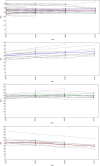BMI trajectories, morbidity, and mortality in England: a two-step approach to estimating consequences of changes in BMI
- PMID: 35920148
- PMCID: PMC9546036
- DOI: 10.1002/oby.23510
BMI trajectories, morbidity, and mortality in England: a two-step approach to estimating consequences of changes in BMI
Abstract
Objective: BMI is known to have an association with morbidities and mortality. Many studies have argued that identifying health risks using single BMI measures has limitations, particularly in older adults, and that changes in BMI can help to identify risks. This study identifies distinct BMI trajectories and their association with the risks of a range of morbidities and mortality.
Methods: The English Longitudinal Study of Aging provides data on BMI, mortality, and morbidities between 1998 and 2015, sampled from adults over 50 years of age. This study uses a growth-mixture model and discrete-time survival analysis, combined using a two-step approach, which is novel in this setting, to the authors' knowledge.
Results: This study identified four trajectories: "stable overweight," "elevated BMI," "increasing BMI," and "decreasing BMI." No differences in mortality, cancer, or stroke risk were found between these trajectories. BMI trajectories were significantly associated with the risks of diabetes, asthma, arthritis, and heart problems.
Conclusions: These results emphasize the importance of looking at change in BMI alongside most recent BMI; BMI trajectories should be considered where possible when assessing health risks. The results suggest that established BMI thresholds should not be used in isolation to identify health risks, particularly in older adults.
© 2022 The Authors. Obesity published by Wiley Periodicals LLC on behalf of The Obesity Society (TOS).
Conflict of interest statement
The authors declared no conflict of interest.
Figures
References
-
- Stamler J. Epidemiologic findings on body mass and blood pressure in adults. Ann Epidemiol. 1991;1:347‐362. - PubMed
-
- Mehrotra C, Naimi TS, Serdula M, Bolen J, Pearson K. Arthritis, body mass index, and professional advice to lose weight: implications for clinical medicine and public health. Am J Prev Med. 2004;27:16‐21. - PubMed
Publication types
MeSH terms
Grants and funding
LinkOut - more resources
Full Text Sources



